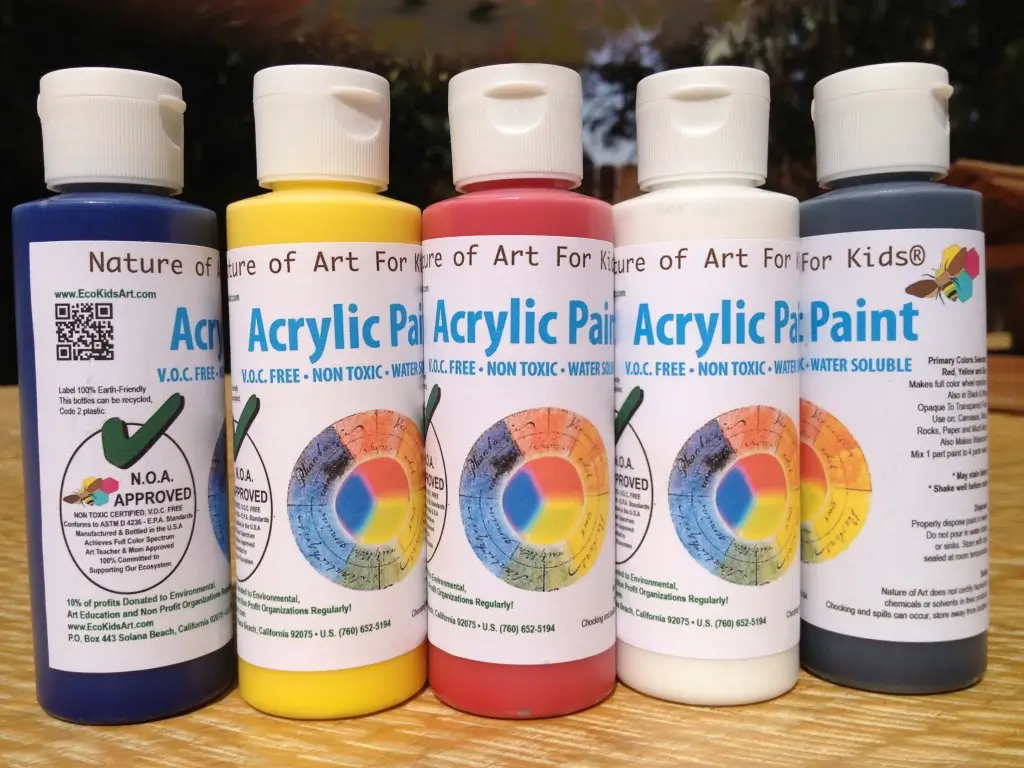You may have a different view, but let us consider this together.
Acrylic paint is widely considered to be a safe paint as it is made using water-based solvents. This is why there is no particular nasty smell associated with acrylic paints.
It is a water-based, non-toxic, and quick-drying paint that can be used for many applications like craft.
Acrylic paints are made of three (3) components:
- Pigments,
- A vehicle and
- A binder.
Vehicles are the liquid part of the paint that holds the pigments in suspension, and binders act like cement, allowing the pigments to stick together and form a paint film. The acrylic vehicle is an acrylic polymer emulsion, and its binder is an acrylic polymer.
When they dry, the components of the vehicle evaporate — meaning that water, propylene glycol, and ammonia are released into the air. Some of the commonly added acrylic mediums also release formaldehyde as they dry.
Considering if the acrylic paint is toxic, let us consider an MSDS report on acrylic paint.
Is Acrylic Paint Toxic?
Let’s see what it contains and the manufacturer’s information;
Acrylic paint MSDS reports
-
Hazard identification
Hazard Classification: Non-hazardous substance. Non-dangerous goods. According to the Criteria of NOHSC and the ADG Code.
Hazard Category: None allocated as non-hazardous.
Risk Phrases: None allocated as non-hazardous.
Safety Phrases: None allocated as non-hazardous.
Warning Statement: No particular hazards are associated with this product.
-
Toxicological information
Acute exposure
Eye contact: Irritating, and may injure eye tissue if not removed promptly.
Skin contact: Low hazard for usual industrial handling or commercial handling by trained personnel.
Inhalation: High gas, vapor, mist, or dust concentrations may be harmful if inhaled. Avoid breathing fumes, spray, vapors, or mist.
Ingestion: The substance may be harmful if swallowed.
Chronic Health Effects:
In some susceptible individuals, possible dermatitis may occur after repeated or prolonged skin contact.
-
Handling and storage
Precautions for Safe Handling: Avoid direct contact with eyes or prolonged contact with skin. Wear appropriate protective equipment to prevent eye contact. Handle and use good occupational hygiene and safety practices.
Conditions for Safe Storage: Store in an area that is cool, dry, and out of direct sunlight with adequate ventilation. Store away from strong oxidizing agents, strong alkalis, and strong acids. Store away from materials or products that react with water. Keep containers closed, when not using the product. Storage in original containers is recommended.
-
Personal protection:
Biological Limit Values: Not known.
Engineering Controls: Maintain adequate ventilation at all times. In most circumstances natural ventilation systems are adequate.
Personal Protection Equipment: Eye/Face Protection: Safety glasses with side shields, goggles, or full-face shields as appropriate are recommended. The final choice of appropriate eye/face protection will vary according to individual circumstances i.e. methods of handling or engineering controls and according to risk assessments undertaken. Eye protection should conform to Australian/New Zealand Standard AS/NZS 1337.
Respiratory Protection: Avoid breathing of vapors/mists; ensure adequate ventilation. Respiration is generally unnecessary; unless working with spray application (airbrush equipment or some other form of atomizing spray equipment). Where a breathing apparatus is required, use either a respirator with an organic/ammonia cartridge, or a Self-Contained Breathing Apparatus (SCBA) with a positive air supply. All breathing apparatus to comply with AS/NZS 1715/1716.
Read Also: Penetration testing in Health and Safety emergency management system
-
First-aid measures
For contact with the eye: Immediately flush eyes with plenty of water for at least 15 minutes holding eyelids open. Get medical attention. Do NOT allow rubbing of eyes or keeping eyes closed.
For skin contact: Wash skin with soap and water. Remove contaminated clothing. Get medical attention if irritation develops or persists.
For inhalation: Remove to fresh air. If not breathing, give artificial respiration. If breathing is difficult, give oxygen. Get immediate medical attention. Do NOT use mouth-to-mouth resuscitation. If you experience difficulty in breathing, leave the area to obtain fresh air. If continued difficulty is experienced, get medical assistance immediately.
For ingestion: If swallowed, rinse mouth with water. If feeling unwell, get medical attention. Swallowing less than an ounce will not cause significant harm. For larger amounts, do not induce vomiting, but give one or two glasses of water to drink and
get medical attention.
Read Also: Why you should avoid using Lead Paint
However, though acrylic paint is relatively safe, it is not without risks. It is recommended that we treat all chemical substances as harmful, except if it is certified safe by the manufacturer.
Recap –
Is acrylic paint toxic?
I will have this to say – For acrylic paint to be safe, safe use is recommended to curtail the risks inherent in the paint.
Related Posts
15 Painting Hazards And Safety Control Measures
Health Effects Of Bitumen Paint Exposure And Safety Precautions
Why You Should Avoid Using Lead Paint
